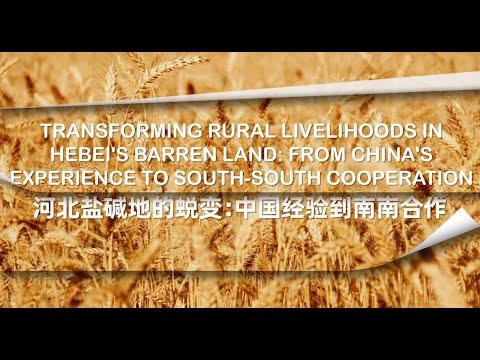(
MENAFN- PR Newswire)
BEIJING, Oct. 18, 2024 /PRNewswire/ --nA
video story presented
by org on Quzhou County's journey from barren to fertile land bearing witness to the resilience of humanity and the power of international cooperation.
Quzhou County, Hebei Province once suffered from severe salinization: white salt efflorescence was everywhere, and the wheat harvested in a year was barely enough to make dumplings for the Chinese New Year.
Continue Reading

Transforming Rural Livelihoods in Hebei's Barren Land
In 1973, experts from the China Agricultural University (CAU) came to Quzhou to explore the comprehensive management of saline-alkaline land by using 400 mu (26.7 acre) of land in Zhangzhuang Village, the most heavily salinized area as the experimental zone.
"The plan implemented by CAU experts here consisted of five measures: digging shallow wells, squaring the fields, planting trees in rows, building roads, and ensuring smooth drainage. Once the salinity problem was solved, the village became a modern countryside," 91-year-old
Zhangzhuang Villager Zhao Wen recalled.
In 1977, the total grain output of Zhangzhuang increased by about two times the historical highest level. The toughest challenge had been resolved, but how could this success be quickly replicated to free the region from salinity as soon as possible? Quzhou faced difficulties due to the huge gap in funding and resources.
As one of the first agricultural foreign investment projects since the Reform and Opening up,Hebei Agriculture Development Loan Agreement Project was approved by United Nations specialized agency, the International Fund for Agricultural Development (IFAD) on September,1982.
This enabled the quick replication of the successful strategies of CAU experts.
The IFAD project covered an area of 280 square kilometers, with a population of 123,100 and arable land area of 350,000 mu (23,333 acre). The lender also provided free food assistance for 5.26 million working days.
The project included the construction of ditches, bridges, gates and culverts, drilling of new wells and repair of old wells, high- and low-voltage transmission lines, the development of animal husbandry, scientific research promotion, technical training, water and soil monitoring, etc.
Saline-alkali land decreased from 166,000 mu (11,067 acre) to 54,400 mu (3627 acre); irrigated land increased from 90,000 mu (6,000 acre) to 212,000 mu (14,133 acre); forest coverage rate increased from 4.7% to 18%; the highest grain yield per mu increased from 181.5 kg to 366 kg in 1987, a 101.7% growth. The annual per capita income of farmers in the project area rose from 76.2 yuan to 379 yuan by 1987.
The rural landscape in northern Quzhou was transformed, with significant improvements in key indicators including grain production, irrigated land, forest coverage, and farmer income. The Quzhou experience then was quickly replicated in the North China Plain.
In 2009, over two decades after the IFAD project's completion, CAU established the country's first Science and Technology Backyard here, carrying out research and promotion of practical new technologies, effectively solving the "last mile" problem in agricultural technology.
Over the past 15 years, this practice has been expanded significantly. China has 157 research institutions that have established 1,800 Science and Technology Backyard to serve rural areas.
The China-Africa Science and Technology Backyard project, launched in 2019, aims to train a group of young people in Africa who understand agriculture, love rural areas, and love farmers.
The newly inaugurated Science and Technology Backyard Africa Center will serve Africa with Malawi as the center of dissemination.
The Quzhou model, created by 50 years of continuous efforts from CAU teachers and students, is profoundly affecting the promotion of agricultural technology in Africa.
IFAD President Mr. Alvaro Lario said South-South and Triangular Cooperation has become a very important element of how China can support the world. We are exploring how we can work together through a multilateral system so that China's experience can be adapted to the context of the target countries and benefit those countries.
Chinese government recently announced an additional Renminbi contribution equivalent to US$10 million to the China-IFAD South-South and Triangular Cooperation Facility to strengthen China's support for promoting rural transformation in the Global South.
IFAD and China are working together to promote the Global Development Initiative, building a new type of South-South Cooperation partnership and contributing to the acceleration of the 2030 Sustainable Development Goals agenda.
Transforming Rural Livelihoods in Hebei's Barren Land: From China's Experience to South-South Cooperation
SOURCE org
WANT YOUR COMPANY'S NEWS FEATURED ON PRNEWSWIRE?
440k+
Newsrooms &
Influencers
9k+
Digital Media
Outlets
270k+
Journalists
Opted In
GET STARTED
MENAFN18102024003732001241ID1108794877
Legal Disclaimer:
MENAFN provides the information “as is” without warranty of any kind. We do not accept any responsibility or liability for the accuracy, content, images, videos, licenses, completeness, legality, or reliability of the information contained in this article. If you have any complaints or copyright issues related to this article, kindly contact the provider above.